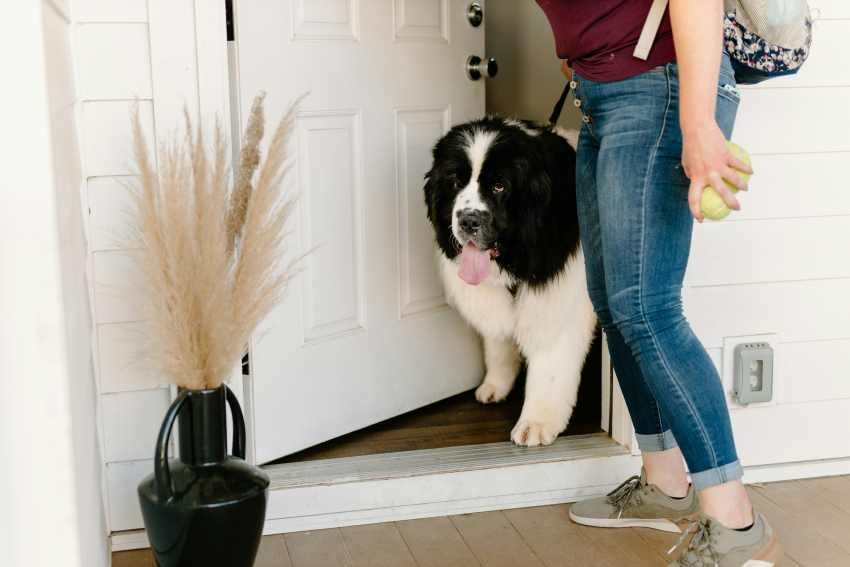Walking your beloved canine companion should be a delightful and stress-free activity for both of you.
However, encountering other dogs during your walks can sometimes lead to unexpected challenges, especially if your dog becomes anxious or reactive.
In this detailed guide, we’ll explore practical strategies and techniques for keeping your dog calm and composed when passing another dog, ensuring that every walk is a pleasant and enjoyable experience.
Understanding the Challenge:
Dogs are inherently social creatures, but their reactions to encounters with other dogs can vary widely based on their individual temperament, past experiences, and socialization levels.
Some dogs may exhibit excitement and eagerness to greet other dogs, while others may feel fearful, insecure, or even aggressive in such situations.
Understanding your dog’s behavior and being able to recognize signs of stress or discomfort is crucial in managing these encounters effectively.

Preparation Is Key:
- Obedience Training: Before embarking on walks, invest time in basic obedience training for your dog. Commands such as “sit,” “stay,” “heel,” and “leave it” are invaluable tools for maintaining control and redirecting your dog’s attention when needed.
- Desensitization Exercises: Gradually expose your dog to other dogs in controlled environments, such as obedience classes or supervised playdates with familiar, well-behaved dogs. This gradual exposure helps desensitize your dog to the presence of other canines and reduces the likelihood of reactive behavior during walks.
- Distraction Techniques: Arm yourself with high-value treats, toys, or a favorite tug-of-war rope to capture your dog’s attention and redirect their focus away from potential triggers, such as passing dogs. Positive reinforcement for calm behavior reinforces desired responses and helps build a positive association with encounters with other dogs.
On the Walk:
- Maintain Distance: As you approach another dog during your walk, assess the situation and maintain a safe distance to prevent your dog from feeling threatened or overwhelmed. Pay attention to your dog’s body language, and be prepared to adjust your route or create more space if necessary.
- Stay Calm and Confident: Dogs are adept at picking up on their owners’ emotions, so it’s essential to remain calm, confident, and relaxed during encounters with other dogs. Keep a loose grip on the leash and avoid tensing up, as this can transmit your own anxiety or apprehension to your dog.
- Use Commands Effectively: Practice using obedience commands such as “heel,” “focus,” or “watch me” to redirect your dog’s attention and reinforce desired behavior. Reward your dog with treats, praise, or a quick game of fetch for complying with commands and remaining calm in the presence of other dogs.
- Be Patient and Persistent: Changing behavior takes time and consistency, so be patient with your dog as they learn to navigate encounters with other dogs during walks. Celebrate small victories and progress, and don’t be discouraged by setbacks or occasional reactive episodes.
Dealing with Reactive Dogs:
- Assess the Triggers: If your dog displays reactive behavior, such as barking, lunging, or growling, take a moment to assess the triggers and underlying causes. Is your dog fearful, territorial, or simply overexcited?
- Create Space: Increase the distance between your dog and the other dog to diffuse tension and minimize the risk of escalation. Use obstacles such as parked cars, bushes, or trees to create a physical barrier if necessary.
- Redirect Attention: Use positive reinforcement techniques to redirect your dog’s attention away from the trigger and back to you. Offer high-value treats, engage in a game of tug-of-war, or practice obedience commands to regain control and focus.
- Seek Professional Guidance: If your dog’s reactive behavior persists or escalates despite your best efforts, consider seeking guidance from a certified dog trainer or behaviorist. A professional can provide personalized advice, behavior modification techniques, and structured training plans tailored to your dog’s specific needs and challenges.
Post-Walk Reflection:
After each walk, take a moment to reflect on the encounter with another dog and evaluate what went well and what areas could be improved.
Did your dog remain calm and focused, or did they exhibit signs of stress or reactivity?
Reflecting on each walk allows you to identify patterns, track progress, and make adjustments to your training approach as needed.
Struggling with leash pulling? It’s time for a change!
The Online Dog Trainer’s Leash Pulling course offers the solution you’ve been searching for. Say goodbye to the frustration of being dragged along on walks and hello to enjoyable, stress-free strolls with your furry companion.
With expert guidance and proven techniques, this course will transform your walks into a harmonious experience for both you and your dog. Don’t wait any longer to take control of your walks – enroll now and unleash the joy of walking with your pup!
The Online Dog Trainer’s Leash Pulling course
Conclusion: Keeping Your Dog Calm When Passing Another Dog
Mastering the art of keeping your dog calm when passing another dog requires patience, consistency, and a deep understanding of your dog’s behavior and needs.
By implementing the strategies outlined in this comprehensive guide and remaining committed to your dog’s training and socialization, you can help your furry friend become a confident, well-behaved companion on walks, ensuring that every outing is a positive and enjoyable experience for both of you.
Related Articles:
How to Stop a Dog Pulling on the Leash
Preventing Leash Pulling: A Guide to Training Your Dog for Pleasant Walks
